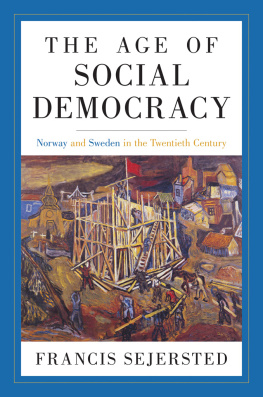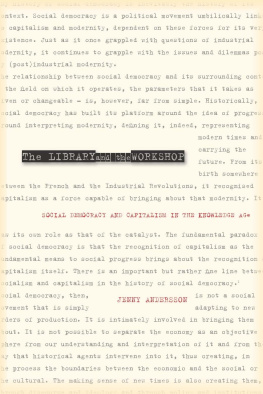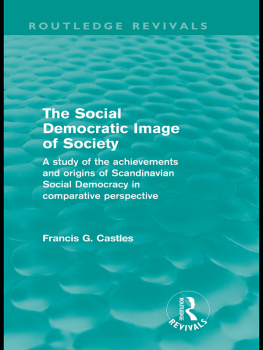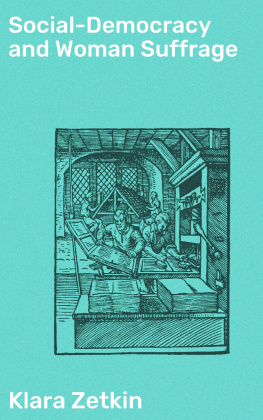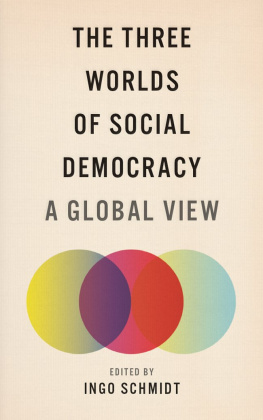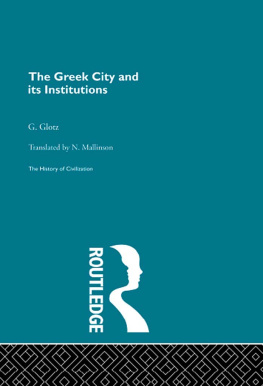Francis Sejersted - The Age of Social Democracy
Here you can read online Francis Sejersted - The Age of Social Democracy full text of the book (entire story) in english for free. Download pdf and epub, get meaning, cover and reviews about this ebook. year: 2021, publisher: Princeton University Press, genre: Politics. Description of the work, (preface) as well as reviews are available. Best literature library LitArk.com created for fans of good reading and offers a wide selection of genres:
Romance novel
Science fiction
Adventure
Detective
Science
History
Home and family
Prose
Art
Politics
Computer
Non-fiction
Religion
Business
Children
Humor
Choose a favorite category and find really read worthwhile books. Enjoy immersion in the world of imagination, feel the emotions of the characters or learn something new for yourself, make an fascinating discovery.
- Book:The Age of Social Democracy
- Author:
- Publisher:Princeton University Press
- Genre:
- Year:2021
- Rating:4 / 5
- Favourites:Add to favourites
- Your mark:
- 80
- 1
- 2
- 3
- 4
- 5
The Age of Social Democracy: summary, description and annotation
We offer to read an annotation, description, summary or preface (depends on what the author of the book "The Age of Social Democracy" wrote himself). If you haven't found the necessary information about the book — write in the comments, we will try to find it.
The Age of Social Democracy — read online for free the complete book (whole text) full work
Below is the text of the book, divided by pages. System saving the place of the last page read, allows you to conveniently read the book "The Age of Social Democracy" online for free, without having to search again every time where you left off. Put a bookmark, and you can go to the page where you finished reading at any time.
Font size:
Interval:
Bookmark:

THE AGE OF SOCIAL DEMOCRACY
THE AGE OF
SOCIAL DEMOCRACY

Norway and Sweden in the Twentieth Century
Francis Sejersted
Translated by Richard Daly with editing by Madeleine B. Adams
PRINCETON UNIVERSITY PRESS
PRINCETON AND OXFORD
Copyright 2011 by Princeton University Press
Published by Princeton University Press, 41 William Street, Princeton, New Jersey 08540
In the United Kingdom: Princeton University Press, 6 Oxford Street,
Woodstock, Oxfordshire OX20 1TW
press.princeton.edu
All Rights Reserved
Library of Congress Cataloging-in-Publication Data
Sejersted, Francis, 1936
[Sosialdemokratiets tidsalder. English]
The age of social democracy : Norway and Sweden in the twentieth century /
Francis Sejersted ; translated by Richard Daly ; with editing by Madeleine B. Adams.
p.cm.
Translation of v. 2 of revised version of: Norge og Sverige gjennom 200 r /
Bo Strth. Oslo : Pax, 2005.
Includes bibliographical references and index.
ISBN 978-0-691-14774-1 (hardcover : alk. paper)
1. SwedenPolitics and government19051950. 2. SwedenPolitics and government19501973.
3. NorwayPolitics and government1905. 4. SocialismSweden
History20th century. 5. SocialismNorwayHistory20th century. 6. Sweden
Social policy. 7. NorwaySocial policy. 8. DemocracySwedenHistory20th century.
9. DemocracyNorwayHistory20th century. I. Adams, Madeleine B. II. Title.
DL861.S45 2011
948.104dc22 2010031673
British Library Cataloging-in-Publication Data is available
eISBN: 978-1-400-83912-4
R0
ACKNOWLEDGMENTS
This book is a thoroughly revised version of a book with the same title published in Norwegian and Swedish in 2005 as the second volume in a two-volume work written to commemorate the dissolution of the Swedish-Norwegian union in 1905. The first volume, written by Bo Strth, covered the history of the two countries during the time of the union from 1814 to 1905, and the second volume the period after the dissolution. It was a natural choice to concentrate the history of the twentieth century on the parallel development of Social Democracy in the two countries.
The present volume has profited enormously from numerous discussions with friends and colleagues and from presentations of aspects of the book in lectures and seminars in Norway and Sweden through many years. I can but mention some of the many to whom I am indebted. A close contact with my friend and colleague Rune Slagstad has been a continuous inspiration. My interest in and knowledge of Swedish history has been developed by the close friendship with my Swedish colleague Gran B. Nilsson. The manuscript of the early version was read and commented on by Torbjrn Nilsson, Thorsten Nybom, and Bo Strth. Single chapters have been read and commented on by Erling Annaniassen, Ole Berg, Grete Brochmann, Jon Erik Dlvik, Anne Lise Ellingster, and Klas mark. I have benefited from reviews of the early version, in particular reviews by Jan Heiret and Knut Kjeldstadli. Three expert readers chosen by Princeton University Press have written invaluable comments, not least the only non-anonymous of the three, Bo Rothstein. I also want to thank all those who helped prepare the book for publication, in particular Ian Malcolm of Princeton University Press, who took interest in the book, and Madeleine Adams for her thorough editing of the English text.
Throughout the many years I have worked on the book, the Institute for Social Research in Oslo has provided me office space in an extremely stimulating milieu. The directors of the institute, Fredrik Engelstad and Ann-Helen Bay, the librarians Sven Lindblad and Jon Hustad, and all their staff have given me the impression that what they most wanted was to help me in every possible way. Last but most important a sincere thanks to my wife Hilde for support and stimulation, a sine qua non for whatever I have achieved throughout our nearly half-century-long companionship.
Francis Sejersted
Oslo, March 2010
THE AGE OF SOCIAL DEMOCRACY
INTRODUCTION
In the 1930s the Social Democratic parties of Sweden and Norway came to power and formed governments in their respective countries. This marked the beginning of a stable period of Social Democratic hegemony. These parties had taken root at the beginning of the twentieth century as revolutionary Marxist parties. They gradually shook off their Marxism, and by the beginning of their period of hegemony they had managed to wrest the great modernization project from the non-Socialist parties and put their own stamp on it. The result is what we might call the Social Democratic orderalso called the Scandinavian model, or simply the Swedish or Nordic model. The Social Democratic order reached its zenith in the 1960s; thereafter it declined. This book presents an account of the development of this order in Sweden and Norway.
Sweden was one of the European great powers during the seventeenth century. By the beginning of the twentieth century this status was only a distant memory, but a more modern ambition was taking shape, a new, forward-looking and benign great power dream: the vision of Sweden as a cutting-edge industrial and economic world power. Something that is more unique to Scandinaviaand particularly to Norwayis the very central place that democratization occupies in the conception of modernization. Modernization is a vague concept that tends to dissolve when one focuses on the concrete historical process, but its comprehensiveness makes it a useful starting point.
Four key aspects of the modernization project should be noted. First, modernization revolves around a liberation project, a liberation from oppressive structures both of the people by democratic institutions and of the individual by the idea of human rights. Liberation is closely linked to scientific rationality, or the demythologizing of the world. This rationality has nourished instrumentalist modes of thought and new ambitions for society building. In other words, in the wake of the Enlightenment the Western world developed an ambitious project to build a free modern society. Consequently, freedom has not come to be associated with dismantling or liquidating but with the building and expanding of society.
There is a paradox, however, in the idea of modernization, a dilemma that springs out of these great ambitions. The struggle to build the ideal society can pose a threat to freedom. All modern societies are faced with the need to find a balance between policies that are democratic, tolerant, and inclusive and those that seek to mold individuals to fit the new society. The contrasts among modern societies are partly due to the different ways in which they have balanced these aims. Hitlers Germany and Stalins Soviet Union are extreme examples of how the modernization project and its ambition of liberation can be perverted to totalitarianism.
Second, modernization stands for economic development through technological progress. This is part of the liberation project: technological development should release people from poverty and from the oppressiveness of work. Here we encounter another dilemma analogous to the first: how to build institutions to serve as the foundation for this technological and economic progress. The many approaches to balancing the objectives of freedom and targeted development have varied from capitalist market solutions to East European command economies.
Font size:
Interval:
Bookmark:
Similar books «The Age of Social Democracy»
Look at similar books to The Age of Social Democracy. We have selected literature similar in name and meaning in the hope of providing readers with more options to find new, interesting, not yet read works.
Discussion, reviews of the book The Age of Social Democracy and just readers' own opinions. Leave your comments, write what you think about the work, its meaning or the main characters. Specify what exactly you liked and what you didn't like, and why you think so.

